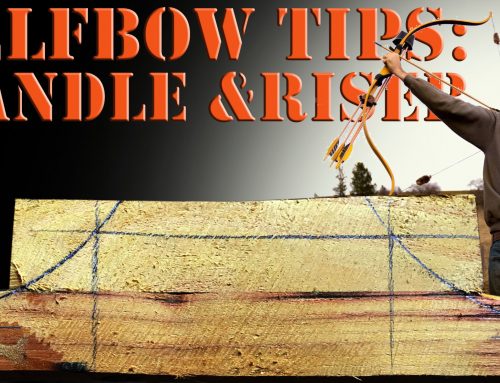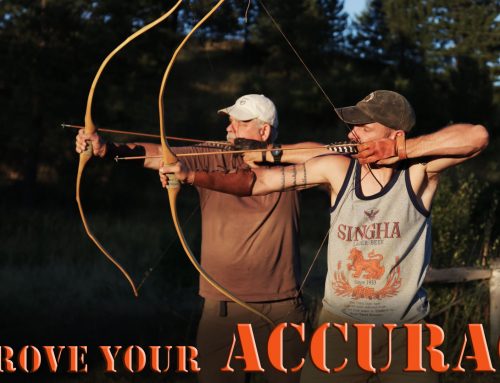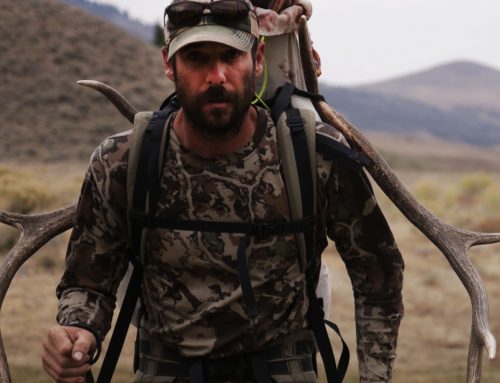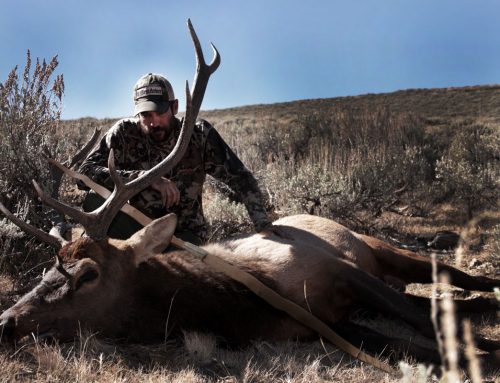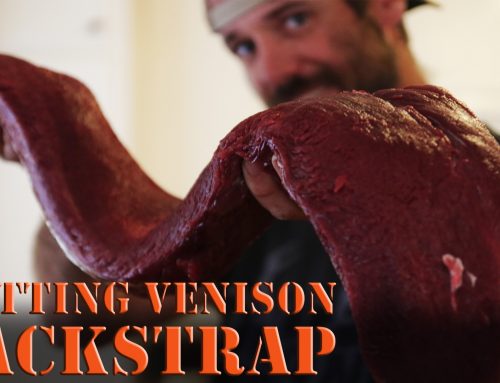Part 2: A Very Special Deer Food
This is part 2 of a two part series on hunting white-tailed deer in feeding and bedding areas. See part 1 for brief introduction.
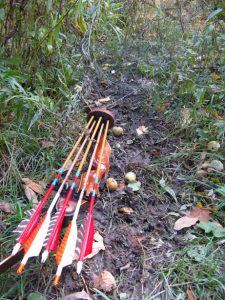
A well worn deer trail through an old apple orchard.
The top of the small apple tree swayed back and forth as if whipped by the wind. Yet the evening was calm, with nothing more than cool air draining down the ridge. I couldn’t see the tree well, but I could clearly hear the dull thud of heavy apples striking the forest floor. After a few minutes, the swaying stopped, but my curiosity kept me focused on the fruit-laden tree some 30 yards down slope. I envisioned a heavy-racked buck shaking the tree with such gusto that it trembled from its roots to its crown. Finally, when the culprit showed its self, I struggled to stifle an audible laugh. A giant buck, yea, right! A small woodchuck was laboring uphill with a red apple wedged in his mouth just below his nose, making him look like a fury, four-legged Bozo the clown. Many don’t realize it, but woodchucks are good climbers and will often scale a tree for prized food. I was so distracted by the woodchuck’s antics that I hadn’t even noticed a doe and her fawn slipping in behind me. The two deer passed by out of range and headed straight for the apples littering the ground beneath the trees in the ancient orchard. Over the next two hours, a steady stream of deer drifted in and out of the orchard. In all, more than a dozen came to feed before shooting light gave way to darkness on that crisp October evening.
The scene described above is common throughout much of the central and eastern portions of the white-tailed deer’s range, including the Finger Lakes region of New York where I hunt. Old orchards and wild apple trees have become an important component of today’s deer woods and not just on private farms. I’ve discovered and hunted old orchards on public land in Georgia, Illinois, Ohio, Pennsylvania, and New York. Most public land was once private and occupied by our agrarian ancestors, who nurtured a personal stock of apples by planting small orchards. Once well cared for islands of fruit trees, these forgotten orchards now sit amid tangled thickets and secondary forests, providing a source of sweet nutrition for deer populations. When ripe apples begin falling in September, the trails leading to these prized feeding sites become rutted and pock marked with cloven hoof prints into early winter.
What is it about an apple tree that draws deer like a magnet? One might say it’s the apples, Stupid! And in part, I would agree with that. But, as with most things in the natural world, there is likely more to the story than the obvious. On a day-to-day and year-to-year basis, deer are driven by the need to eat and reproduce. Food is essential for growth and survival, and evolutionary biology teaches us that any species’ ultimate goal is to pass its genes on to the next generation. It is obvious how apple trees satisfy a deer’s hunger, but what role do they play in reproduction and the communication associated with it?
Old orchards consistently bustle with deer activity, creating a hub of interaction throughout the year. In winter, deer frequently visit apple trees to scavenge any remaining apples and to browse heavily from the tree’s drooping branches. Deer love apple browse and when the fruits aren’t available, stems are the next best things. In Charles Alsheimer’s book Quality Deer Management: The Basics and Beyond, he lists wild apple as the most highly preferred browse by his captive deer, which are given a choice of many natural browse types to select from. In spring and summer a new, and often overlooked, food becomes available in old orchards. Mushrooms and other fungi play an important role in the white-tailed deer’s summer diet and any experienced morel hunter can tell you that old apple orchards are THE place to find a bounty of fungi. In autumn, the annual cycle is completed when deer beat paths to old orchards in search of sweet, ripe apples that often fall from August to December.
This year-round activity leads to what I call the bulletin board effect. A bulletin board is a place where humans leave messages for each other. The boards are often placed near a point that focuses human activity, such as the entrance to a grocery store. I believe old apple orchards and the habitat immediately surrounding them are analogous to the grocery store and its bulletin board—deer are initially attracted by the food, but take advantage of the constant activity to communicate with each other. For instance, most old orchards have a concentration of rubs and scrapes nearby. In addition, the year’s first rubs and scrapes often show up in and around old orchards weeks before they are evident in other habitats. A close look reveals that old orchards are like an open book of deer biology waiting to be read by the knowing hunter.
Interpreting Orchard Sign
Spot-checking orchards for sign can reveal a lot about the deer that are using it. For instance, tracks, rubs, and scrapes can tell you about the number of deer and quality of bucks visiting the site. If your goal is to ambush a doe or “teenage buck,” then simply knowing that deer regularly use the orchard may be enough to set up an effective treestand or ground blind. However, if you’ve got your sights set on a mature buck, you may want to investigate further. Much of the mature buck sign in orchards is made at night and provides good evidence of the deer in your area, but by itself this sign may not get you within shooting range. The most useful information can be gained when the orchard is viewed as the hub of a wheel with the trails leading to it representing spokes.
Most food sources, such as large crop fields and oak flats, have scattered trails that are often difficult to backtrack to bedding areas. In contrast, old orchards are usually discrete locations with concentrated trails, or spokes, running to and from them. These spokes often lead to bedding areas, staging areas, and protected secondary travel routes that mature bucks prefer. Follow the spokes away from the orchard and look for rubs, or better yet rub lines that break off toward thick undisturbed places that are used for bedding. Transitional cover near these bedding sites may serve as staging habitat for bucks that are waiting to make their final move toward the orchard after dark. Also, look for faint secondary trails that join the main trail. These often follow creek bottoms or other lines of topography. During the rut bucks will use these trails to search for estrus does during almost any time of day. Now for the bad news…all orchards aren’t equally good when it comes to their value for hunting and scouting.
In general, large commercially active orchards aren’t ideally suited for hunting. They often receive a lot of human disturbance and their large size causes deer and the clues they leave behind to be dispersed over a wide area, making it difficult to pinpoint stand locations and interpret sign. Similarly, wild apple trees in open areas are less than ideal. These are often difficult to hunt and mostly visited by deer at night because of a lack of protective cover. I look for old orchards, or even single mature apple trees in abandoned areas where forests and thickets have grown up to provide cover and bedding areas. Maybe the best way to explain orchard-hunting is through the stories of two different bucks I have tagged as a result of taking my cues from apples trees.
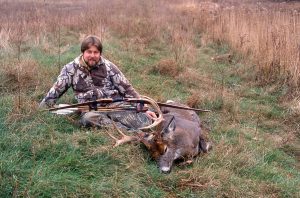 The Dogwood Buck—One of my favorite stands is located in a very large, dense dogwood thicket that was once a farm field. Cleaving the 50-acre thicket is a narrow, brushy creek bottom dotted with ashes, hickories, maples, and a cluster of scraggly old apple trees; planted decades earlier when the location was actively farmed. It’s a safe haven where deer bed and sometimes feed during the day. It’s also a place I turn to when things aren’t going my way. This was the case several years ago when the archery season came and went without me taking a buck. I passed on several mediocre bucks and came very close sealing the deal on a nice 3.5-year-old 9 point, but overall I just couldn’t get it together. The late archery season in mid-December would be my final chance. With just three days left to hunt, I made a late-morning trip to the dogwood thicket, hoping to ambush a buck feeding on one of the thicket’s few food sources…apples. When I arrived with my climber, I was pleased to see a few frozen apples still hanging from the decrepit trees. Surely, deer would be periodically checking the spot in search of an easy winter meal. By 9:30 I was positioned 15 feet off the ground on the edge of the frost-covered dogwoods, 20 yards from the apple trees. By noon, I still hadn’t seen a deer and Jack Frost’s nip was biting at my hands and feet. Getting into this spot without disturbing bedded deer is a test of stealth and patience, and I was wondering if I’d failed the test. But then, there it was–over my right shoulder. Crunch-crunch. The sounds of a walking deer. Soon I could see patches of brown, then a flash of antler in the dogwoods. I repositioned my feet and lifted my longbow from the stand. When he reached an opening by the nearest apple tree, instinct took over and the arrow was on its way. The red and white-fletched shaft pierced his hide just behind the left shoulder and the buck bolted back into the dogwoods. The tracks and blood on the newly fallen snow were easy to follow. Kneeling over the 8-pointer I realized it was one of the bucks I’d passed up many weeks earlier.
The Dogwood Buck—One of my favorite stands is located in a very large, dense dogwood thicket that was once a farm field. Cleaving the 50-acre thicket is a narrow, brushy creek bottom dotted with ashes, hickories, maples, and a cluster of scraggly old apple trees; planted decades earlier when the location was actively farmed. It’s a safe haven where deer bed and sometimes feed during the day. It’s also a place I turn to when things aren’t going my way. This was the case several years ago when the archery season came and went without me taking a buck. I passed on several mediocre bucks and came very close sealing the deal on a nice 3.5-year-old 9 point, but overall I just couldn’t get it together. The late archery season in mid-December would be my final chance. With just three days left to hunt, I made a late-morning trip to the dogwood thicket, hoping to ambush a buck feeding on one of the thicket’s few food sources…apples. When I arrived with my climber, I was pleased to see a few frozen apples still hanging from the decrepit trees. Surely, deer would be periodically checking the spot in search of an easy winter meal. By 9:30 I was positioned 15 feet off the ground on the edge of the frost-covered dogwoods, 20 yards from the apple trees. By noon, I still hadn’t seen a deer and Jack Frost’s nip was biting at my hands and feet. Getting into this spot without disturbing bedded deer is a test of stealth and patience, and I was wondering if I’d failed the test. But then, there it was–over my right shoulder. Crunch-crunch. The sounds of a walking deer. Soon I could see patches of brown, then a flash of antler in the dogwoods. I repositioned my feet and lifted my longbow from the stand. When he reached an opening by the nearest apple tree, instinct took over and the arrow was on its way. The red and white-fletched shaft pierced his hide just behind the left shoulder and the buck bolted back into the dogwoods. The tracks and blood on the newly fallen snow were easy to follow. Kneeling over the 8-pointer I realized it was one of the bucks I’d passed up many weeks earlier.
The Runway Buck—The runway was a place I’d walked past a thousand times, but never bothered to checkout until I was guided there by a rub line leading from an old orchard. From the outside, the narrow 40-yard wide strip of trees looked impenetrable, with its forbidding understory of multiflora rose, honeysuckle, and dogwood. But inside its perimeter of brush, was a relatively open runway with a heavy deer trail at its center. The 150-yard long runway was cut off by a road on one end, but connected to a brushy power line on the other. When I first discovered the runway in late October, it was lined with rubs and scrapes. This was a place bucks visited often, but why? After hunting there several times, I finally figured it out. The runway was the only concealed trail that ran parallel to a doe bedding area that stood about 100 yards away across an open field. It was the one safe travel corridor bucks could use during daylight to scent check for estrus does that had already crossed over to the bedding area. After hitting the apple trees just before daylight, bucks would cruise the runway for does before using the powerline to bed or travel on to some other location. Nearly every time I hunted the runway I saw bucks, but nothing big enough to account for some of the rubs I was seeing…that is until November 15th.
It was cold for November with overnight temperatures dipping into the lower teens. I arrived at the runway just as the first glow of pink sunlight cracked the eastern sky. My perch was in a small red maple just downwind of the main trail. For the first hour nothing stirred. It seemed that all the forest’s creatures were sleeping in to avoid the cold. When I first heard the sound I wasn’t sure what it was….tick, tick, tick. It had the rhythm of a deer’s gait, but not the right sound. The sound grew closer and I swiveled my head to find its source. Eventually I could see a
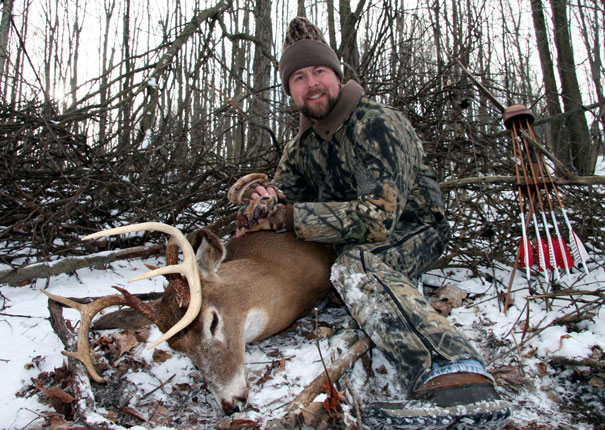
deer’s legs in the heavy brush behind me. When the legs began moving the faint ticking returned. I realized it was the sound of hooves on frozen ground. Soon the deer entered an opening and I got my first glimpse of his spectacular long-tined rack. He was now angling away from me with no chance for a shot, so I quickly fished a bleat call from my pocket…blhaaaat, blhaaaat…the buck turned and headed my way! He continued on, but stopped short of my shooting lane. Come on, come one I urged. Perhaps my silent urging worked too well as the buck continued on at a fast walk. I picked a spot that would compensate for his movement, brought my longbow to full draw, and released. The buck catapulted from the runaway and all drew quiet again. Did that really happen, I thought? Indeed it did. I recovered the buck, a nine point with a split brow tine and two kicker points, the following day after a long tracking adventure, which is described in Chapter 15 of my book, A Traditional Bowhunter’s Path.
Unraveling a buck’s movement patterns takes a bit of observation and a huge dose of luck. Cuing in on old apple orchards is a good place to start, but like any other whitetail hunting technique, it’s no magic bullet. It’s just one more piece of the puzzle that might help fill your freezer or decorate your wall.
